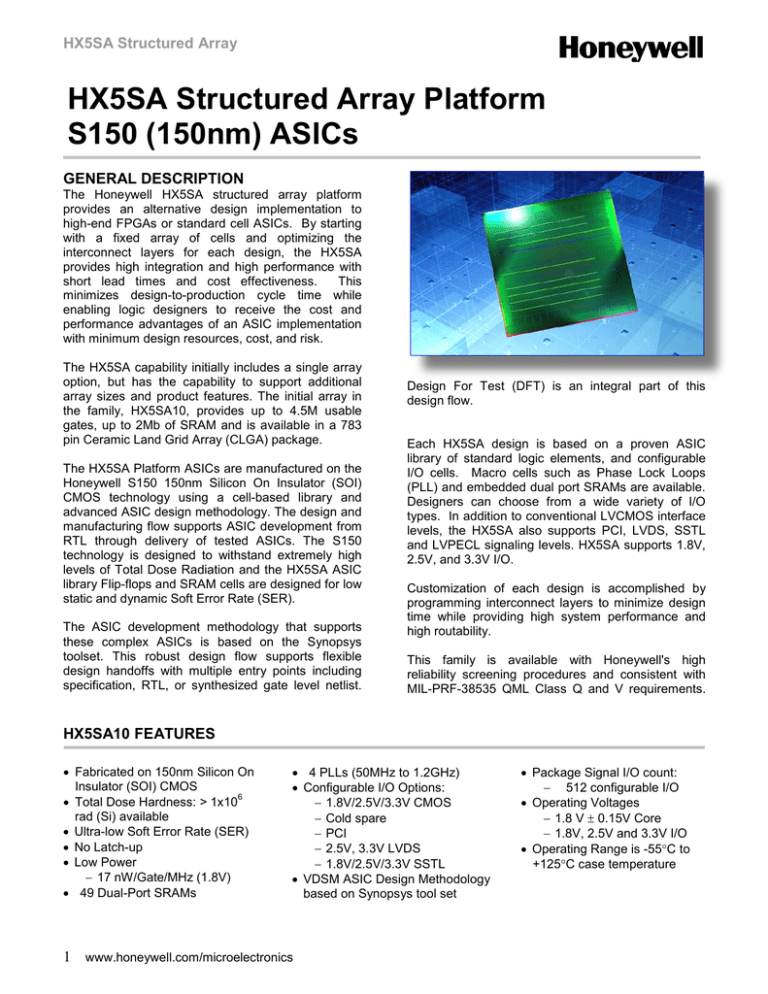HX5SA - Honeywell Aerospace
advertisement

HX5SA Structured Array HX5SA Structured Array Platform S150 (150nm) ASICs GENERAL DESCRIPTION The Honeywell HX5SA structured array platform provides an alternative design implementation to high-end FPGAs or standard cell ASICs. By starting with a fixed array of cells and optimizing the interconnect layers for each design, the HX5SA provides high integration and high performance with short lead times and cost effectiveness. This minimizes design-to-production cycle time while enabling logic designers to receive the cost and performance advantages of an ASIC implementation with minimum design resources, cost, and risk. The HX5SA capability initially includes a single array option, but has the capability to support additional array sizes and product features. The initial array in the family, HX5SA10, provides up to 4.5M usable gates, up to 2Mb of SRAM and is available in a 783 pin Ceramic Land Grid Array (CLGA) package. The HX5SA Platform ASICs are manufactured on the Honeywell S150 150nm Silicon On Insulator (SOI) CMOS technology using a cell-based library and advanced ASIC design methodology. The design and manufacturing flow supports ASIC development from RTL through delivery of tested ASICs. The S150 technology is designed to withstand extremely high levels of Total Dose Radiation and the HX5SA ASIC library Flip-flops and SRAM cells are designed for low static and dynamic Soft Error Rate (SER). The ASIC development methodology that supports these complex ASICs is based on the Synopsys toolset. This robust design flow supports flexible design handoffs with multiple entry points including specification, RTL, or synthesized gate level netlist. Design For Test (DFT) is an integral part of this design flow. Each HX5SA design is based on a proven ASIC library of standard logic elements, and configurable I/O cells. Macro cells such as Phase Lock Loops (PLL) and embedded dual port SRAMs are available. Designers can choose from a wide variety of I/O types. In addition to conventional LVCMOS interface levels, the HX5SA also supports PCI, LVDS, SSTL and LVPECL signaling levels. HX5SA supports 1.8V, 2.5V, and 3.3V I/O. Customization of each design is accomplished by programming interconnect layers to minimize design time while providing high system performance and high routability. This family is available with Honeywell's high reliability screening procedures and consistent with MIL-PRF-38535 QML Class Q and V requirements. HX5SA10 FEATURES • Fabricated on 150nm Silicon On Insulator (SOI) CMOS 6 • Total Dose Hardness: > 1x10 rad (Si) available • Ultra-low Soft Error Rate (SER) • No Latch-up • Low Power − 17 nW/Gate/MHz (1.8V) • 49 Dual-Port SRAMs • 4 PLLs (50MHz to 1.2GHz) • Configurable I/O Options: − 1.8V/2.5V/3.3V CMOS − Cold spare − PCI − 2.5V, 3.3V LVDS − 1.8V/2.5V/3.3V SSTL • VDSM ASIC Design Methodology based on Synopsys tool set 1 www.honeywell.com/microelectronics • Package Signal I/O count: − 512 configurable I/O • Operating Voltages − 1.8 V ± 0.15V Core − 1.8V, 2.5V and 3.3V I/O • Operating Range is -55°C to +125°C case temperature HX5SA Structured Array TECHNICAL DESCRIPTION S150 SOI CMOS Description The Honeywell technical approach for development of HX5SA ASICs utilizes our state-of-the-art 150nanometer SOI CMOS (S150) technology. SOI CMOS offers advantages for high-performance applications not attainable in standard bulk CMOS for radiation hardened applications. SOI devices are fabricated in a thin film of silicon on top of a buried oxide insulator on top of a standard silicon wafer. SOI has a proven history of resistance to SEU and immunity to latch-up. These advantages simplify design steps, improve density and reduce a variety of parasitic capacitances. Reduced Power Consumption − SOI technology offers lower capacitance than bulk CMOS of the same feature size resulting in lower power reduction 1.8V core operating voltage 1.8V, 2.5V, 3.3V I/O operating voltage options − − HX5SA Technical Parameters HX5SA Characteristics Layers of Metal Minimum Geometry Operating Voltage (Core) Operating Voltage (I/O) Typical Intrinsic Delay-2 Input NAND (fan out =2) Typical Power Dissipation, nW/Gate/MHz 20% Data, 200% Clock Activity Rate Operating Temperature ESD (Human Body Model) Value 6 0.15 µm drawn /0.11 µm Leff 1.8 + 0.15V 1.8 + 0.15V, 2.5 + 0.2V, 3.3 + 0.3V 60 ps @ 1.8V 17 @ 1.8V o o -55 C to 125 C >2000 Volts HX5SA10 Specifications Parameter Die Size Usable Gates Total Number of SRAM bits Number of 512x36 Dual Port SRAMs Number of 1K X 36 Dual Port SRAMs Number of 2K X 36 Dual Port SRAMs Number of PLLs PLL Operating Frequency Number of I/O Signals Number of VSS bond wires Number of VDD (core) bond wires Number of VDDIO bond wires Value 16mm x 16mm 4. 5 Million (1) 2.0 M 10 each on top and bottom 14 on right side, 1 on left side 14 on the left side 4, one on each side 50MHz to 1.2GHz 512 136 64 72 Notes: (1) The number of routable gates is dependent on several other factors including routing densities, amount of RAM used and I/O quantity. 2 www.honeywell.com/microelectronics HX5SA Structured Array HX5SA10 Floor Plan Diagram (for reference, not to scale) I/O, Power and Ground 512 x 36 512 x 36 512 x 36 512 x 36 512 x 36 PLL 512 x 36 512 x 36 512 x 36 512 x 36 2k x 36 1k x 36 2k x 36 1k x 36 2k x 36 1k x 36 2k x 36 1k x 36 1k x 36 2k x 36 1k x 36 2k x 36 1k x 36 Gate Array Cells 1k x 36 PLL PLL 1k x 36 2k x 36 1k x 36 2k x 36 1k x 36 2k x 36 I/O, Power and Ground I/O, Power and Ground 2k x 36 1k x 36 2k x 36 1k x 36 2k x 36 1k x 36 2k x 36 1k x 36 2k x 36 512 x 36 512 x 36 512 x 36 512 x 36 512 x 36 512 x 36 PLL 512 x 36 512 x 36 512 x 36 512 x 36 512 x 36 I/O, Power and Ground RADIATION CHARACTERISTICS Total Ionizing Radiation Dose The Structured Array will meet all stated functional and electrical specifications after the specified total ionizing radiation dose. All electrical and timing performance parameters will remain within specifications, after an operational period of 15 years. Total dose hardness is assured by wafer level testing of process monitor transistors and RAM product using 10 KeV X-ray. Parameter correlations have been made between 10 KeV X-rays applied at dose 5 5 O rates of 1x10 to 5x10 rad(SiO2)/min at T= 25 C and gamma rays (Cobalt 60 source) to ensure that wafer level X-ray testing is consistent with standard military radiation test environments. Transient Pulse Ionizing Radiation Honeywell supports the highest levels of transient pulse radiation hardness. Please contact Honeywell for more information and specifications for applications requiring transient pulse hardness. 3 www.honeywell.com/microelectronics Neutron Radiation The library elements will meet any functional or timing specification after exposure to the specified neutron fluence under recommended operating or storage conditions. This assumes an equivalent neutron energy of 1 MeV. Soft Error Rate The library elements are capable of meeting the specified Soft Error Rate (SER), under recommended operating conditions. The specification applies to both heavy ion and proton. This heavy ion hardness level is defined by the Adams 90% worst case cosmic ray environment for geosynchronous orbits. The HX5SA library contains several types of storage elements, including registers and embedded RAM, which provide options for single event effect mitigation. Latchup The array will not latch up due to any of the above radiation exposure conditions when applied under recommended operating conditions. Fabrication with the SOI substrate material provides oxide isolation between adjacent PMOS and NMOS transistors and eliminates any potential SCR latchup structures. Sufficient transistor body tie connections to the pchannel and n-channel substrates are made to ensure no source/drain snapback occurs. HX5SA Structured Array Radiation-Hardness Ratings Parameter Total Dose Limits > 1 x 106 Soft Error Rate (1)(3) SEUN Flip Flop SEUT1 Flip Flop SEUT2 Flip Flop SEUT3 Flip Flop Standard -8 ≤ 5 x 10 -10 ≤ 2 x 10 -11 ≤ 4 x 10 -11 ≤ 1 x 10 Asynch. -8 ≤ 5 x 10 -10 ≤ 6 x 10 -10 ≤ 1 x 10 -11 ≤ 5 x 10 SRAM (Dual Port) ≤ 7 x 10-15 14 Neutron Fluence 1x10 Units Rad(Si) Test Conditions VDD= 1.95 Volts, VDD3= 3.6 Volts, Tc = 25°C, Co60 Upsets/bit-day (2) Upsets/bit-day (2) Upsets/bit-day (2) Upsets/bit-day (2) VDD= 1.65 – 1.95 Volts VDD3= 3.3 Volts TC = 25°C (static or dynamic clock) Upsets/bit-day (2) N/cm 2 1MeV equivalent energy (1) There are multiple types of registers with different SER ratings to allow optimization of overall ASIC speed. (2) Adams 90% W.C. environment GEO orbit, 100 mil shielding (3) Standard – registers without asynchronous input pins ie dffq, dffq_scl, dffq_syr Asynch – registers with asynchronous input pins ie dffq_ar, dffq_ash HX5SA LIBRARY The HX5SA library contains more than 220 standard library cells with a broad array of cell types. Many logic functions have multiple versions available to allow for trade-offs of radiation tolerance, speed, power consumption, and I/O drive strengths. Flip flops and memory cells are available in several SEU levels to support different radiation requirements. dual port SRAM is shown in the figure below. If the read port accesses a location which is simultaneously being written to by the write port, the value on DOUT will be unknown. The library is designed to support use of Synopsys TM Module Compiler . Module Compiler is a tool for creating high-performance, datapath-intensive modules. Embedded SRAMs The HX5SA family includes embedded SRAM blocks to efficiently implement large memory structures. The embedded SRAMs provide radiation hardness, high density and high performance in a dual port configuration. Access to the memory data is controlled through separate read and write ports, thus providing concurrent read and write operations. SRAMs retain data content as long as power is supplied to the memory device. The HX5SA10 contains 49 separate embedded dual port SRAM blocks including twenty 512x36 SRAMs, fifteen 1024x36 SRAMs and fourteen 2048x36 SRAMs. The designer can implement a wider-word SRAM by connecting multiple SRAM blocks side by side, or deeper memory can be achieved by stacking multiple SRAM blocks. Typical access times are 2 to 3 ns. The HX5SA dual port SRAMs have separate read and write ports. Dual port SRAMs are synchronous and use a write clock and a read clock to register inputs and outputs. A block diagram of an HX5SA 4 www.honeywell.com/microelectronics Embedded Phase Lock Loops The HX5SA10 contains 4 high performance embedded Phase Lock Loop (PLL) circuits. There is one PLL circuit in the middle of each side of the die. These circuits can be used to provide frequency synthesis, insertion delay cancellation, highfrequency clock synchronization or clock multiplication on chip. The range of the PLL operating frequency is 50MHz to 1.2GHz. The table below lists the general specifications of the PLLs. HX5SA Structured Array PLL Electrical Performance Specifications Parameter OUTCLK frequency Symbol fOUTCLK Min 50 REFCLK frequency fREFCLK FBKCLK frequency Maximum Power Analog Power Supply Voltage Digital Power Supply Voltage Frequency multiplication VCO I (50-200 MHz) VCO II (180-630 MHz) VCO III (600-1200 MHz) Typ Max 1200 Unit MHz 25 500 MHz fFBKCLK 25 500 MHz Pmax VDDA VDD N 1.65 1.65 40 1.95 1.95 mW V V N N N 1 1 2 1.8 1.8 10 32 40 250 Lock Time REFCLK Input rise/fall time Jitter Minimum Pulse Width High Minimum Pulse Width Low tr/f Jpp Maximum load Output Jitter (Phase) VCO I (50-200 MHz) CL Jpp Jpp 0.16 Comment Use FS[2:0] to select OUTCLK range. fOUTCLK=1200MHz Max divide ratio from OUTCLK and FBKCLK to multiply fREFCLK FS = 000, 001 FS = 010, 011 FS = 100, 101 us 0.33 150 ns ps p-p ps ps 400 fF 60 40 ps ps FS = 000, 001 FS = 010, 011 40 100 ps ps FS = 100, 101 OUTCLK= 50 - 1200MHz 800 800 10 – 90 % fREFCLK=500MHz OUTCLK VCO II (180-630 MHz) VCO III (600-1200 MHz) Output Jitter (Cycle to Cycle) Jpp Jpp Jpp (cc) HX5SA I/O Options Honeywell’s HX5SA family I/O cells provide a wide variety of user options for interfacing to other devices in the system. The I/O cells provide buffering and drive for signals entering or leaving the device. In addition to conventional LVCMOS interface levels, the HX5SA family I/O also supports LVDS, LVPECL, SSTL18, SSTL2, SSTL3 and PCI signaling levels. The CMOS I/O may also suffice for many low-voltage TTL interfaces depending on specific system requirements. loading the active drive on other active parts as long as the I/Os are put in a high-Z state during the power supply transitions. This can enhance overall system lifetime by enabling the replacement of parts that have become defective with redundant cold spare equipped parts. Parts can also be powered down when not needed to minimize the degradation caused by electrical fields and/or to conserve power. This feature is an option for LVCMOS I/O and is present on LVDS inputs. The cold spare I/O feature allows a part to be powered down (VDDIO/VDD=VSS), have its VDD and VDDIO pins ramped up from VSS, or have its power pins ramped down within a system without The tables below summarize the HX5SA I/O options. 5 www.honeywell.com/microelectronics HX5SA Structured Array HX5SA I/O SUMMARY TABLE Description Operating Voltages Operating Frequency (1) Features LVCMOS 1.8V, 2.5V, 3.3V Up to ~150 MHz PCI 3.3V 33MHz / 66MHz SSTL 1.8V, 2.5V, 3.3V Up to 250 MHz LVDS 2.5V, 3.3V 600 Mb/s LVPECL 3.3V Up to 1.2GHz (Clock) Up to 1.2Gb/s (Data) Input, Output, Tri-state, Bi-directional, Pad Pull, Cold Spare, Schmitt, Drive strength, Pad pull Input, Output, Tri-state, Bi-directional, 33MHz, 66MHz Class I & II, Input, Output, Tri-state, Bidirectional, Terminated or Unterminated Input, Output, Cold Sparing, Terminated or unterminated Input, Output, DC Coupled Notes (1) System level speeds may be slightly different based on impacts from the transmission line medium. ASIC METHODOLOGY AND CAD TOOLS The design flow infrastructure for HX5SA ASICs has been developed by Honeywell and Synopsys. This design environment includes: • • • Leading-edge Synopsys EDA tools for designing and verifying complex ASICs A flexible set of front-end and back-end design services from design teams expert in the implementation of advanced ASICs and the HX5SA design flow Access to intellectual property (IP) cores from Honeywell and Synopsys’ DesignWare IP, to accelerate design time and reduce development costs. Along with support for traditional and expanded ASIC handoff options, implementation support may include design services available from Honeywell and in a fully collaborative design model. ASIC Development Flow The ASIC development flow processes a design from the ASIC specification through tested ASIC delivery. For ASIC designs that push the performance envelope, the flow is configured to support preliminary synthesis and place and route, termed “advanced prove-out”, to converge on an optimized design which meets all the performance constraints. The requirements associated with packaging and test are also addressed as part of the ASIC development. Design For Test (DFT) Honeywell has integrated Design For Test (DFT) into the HX5SA ASIC Development Flow. It encompasses 6 www.honeywell.com/microelectronics Memory Built In Self Test (MBIST), Scan/Boundary Scan, ATPG, and Functional test. It is designed to be a complete test process that allows for simulation and hardware test to use the same functional test vectors. The DFT flow is supported by tools from Mentor Graphics, Synopsys and Credence. TEST CAPABILITIES Honeywell HX5SA test capabilities include wafer and packaged part level testing. Testing capabilities encompass the complete Class Q and V screening flows. The test platform is based on testers manufactured by Credence among others and includes the EXA3000-800 digital tester. The EXA3000-800 has a maximum of 1024 digital I/O pins. These consist of 960 channels that are singleended and have a maximum data rate of 800Mbps. It also has 32 differential channels supporting rates up to 3.2Gbps data rates. This tester has pin and system level Precision Measurement Units (PMU), timing measurement unit, Sequencer Per Pin (SPP) pattern generator used for digital functional testing, and a 3.2Gbps Wavecrest SIA. The EXA3000 test system is also designed to support true mixed-signal test techniques using a patented analog channel architecture that is integrated with the digital sub-system. It is equipped with two BroadBand Channel (BBC) instruments and a High Accuracy (HA) instrument. HX5SA Structured Array HX5SA DEVELOPMENT FLOW DIAGRAM Honeywell uses an industry standard design flow, shown in the figure below. Synthesis libraries are provided for Synopsys Design Compiler. Libraries are provided for Verilog logic simulation. Multiple entry points are available for dividing tasks between Honeywell and the customer, a common one is shown in this figure. In the flow shown, the designer performs the RTL coding, synthesis, pre/post-route timing and functional verification. Honeywell performs the entire back end layout, timing convergence and test program generation. Design Kickoff Customer Design and Handoff Activities Customer Task Honeywell Task RTL Customer & Honeywell Task Test Vector Generation Synthesis (Honeywell Libraries) Static Timing Requirements Timing Verification Timing Script(s) Final Netlist/Timing Constraints/Test Vectors to Honeywell/ IDR / PDR Pre-Route Timing Verification Place and Route Extract SDF & Netlist Optimize Placement Timing Closure Post-Route Timing Verification Honeywell Place and Route Activities Formal Verification Test Gen / ATPG / CTR Design Verification/ CDR Tapeout 7 www.honeywell.com/microelectronics HX5SA Structured Array PACKAGING The HX5SA10 is available in a 783 pin Ceramic Land Grid Array (CLGA). 8 www.honeywell.com/microelectronics RELIABILITY For more than 20 years Honeywell has been producing integrated circuits that meet the stringent reliability requirements of space and defense systems. Honeywell has delivered thousands of QML parts since first becoming QML qualified in 1990. Using this proven approach Honeywell will assure the reliability of the S150 products. This approach includes adhering to Honeywell’s General Manufacturing Standards for: • Designing in reliability by establishing electrical rules based on wear out mechanism characterization performed on specially designed test structures (electromigration, TDDB, hot carriers, negative bias temperature instability, radiation) • Utilizing a structured and controlled design process • A statistically controlled wafer fabrication process with a continuous defect reduction process • Individual wafer lot acceptance through process monitor testing (includes radiation testing) • The use of characterized and qualified packages • A thorough product testing program based on MIL-PRF-38535 and MIL-STD 883. QUALIFICATION AND SCREENING The S150 technology has been qualified by Honeywell after meeting the criteria of the Honeywell General Manufacturing Standards. This approval is the culmination of years of development and requires a considerable amount of testing, documentation, and review. The S150 technology and HX5000 ASIC technology are QML Qualified. This requires additional testing, documentation, and DLA Land and Maritime approval. The test flow includes screening units with the defined flow (Class V and Q equivalent) and the appropriate periodic or lot conformance testing (Groups B, C, D, and E). Both the S150 process and individual product are subject to period or lot based Technology Conformance Inspection (TCI) and Quality Conformance Inspection (QCI) tests, respectively. Periodic qualification and testing at Honeywell and Suppliers address the following requirements. Group A Group B Group C Group D Group E General Electrical Tests Mechanical - Bond Strength, Solvents, Die Shear O Life Tests - 1000 hours at 125 C or equivalent Package related mechanical tests Dimensions, Mechanical Shock, Vibration, Acceleration, Seal, Temp Cycle, Thermal Shock, Moisture Resistance, Salt, Lead Integrity, Lead Finish Adhesion, Solderability, Internal Water Vapor, Solder Heat Radiation Tests Honeywell delivers products that are tested to meet your requirements. Products can be screened to several levels including Proof of Design (POD), Engineering Models (EMs), and Flight Units. PODs and EMs are available with limited screening for prototype development and evaluation testing. For further questions, please call for applications support at 800-323-8295 (USA toll free) or 763-954-2474 or visit our website www.honeywell.com/microelectronics. Honeywell reserves the right to make changes to any products or technology herein to improve reliability, function or design. Honeywell does not assume any liability arising out of the application or use of any product or circuit described herein; neither does it convey any license under its patent rights nor the rights of others. Honeywell International Inc. Aerospace Plymouth 12001 Highway 55 Plymouth, MN 55441 1-800-323-8295 www.honeywell.com/microelectronics Form #900327 August 2011 ©2011 Honeywell International Inc.



